Exploring West Africa’s Wonders
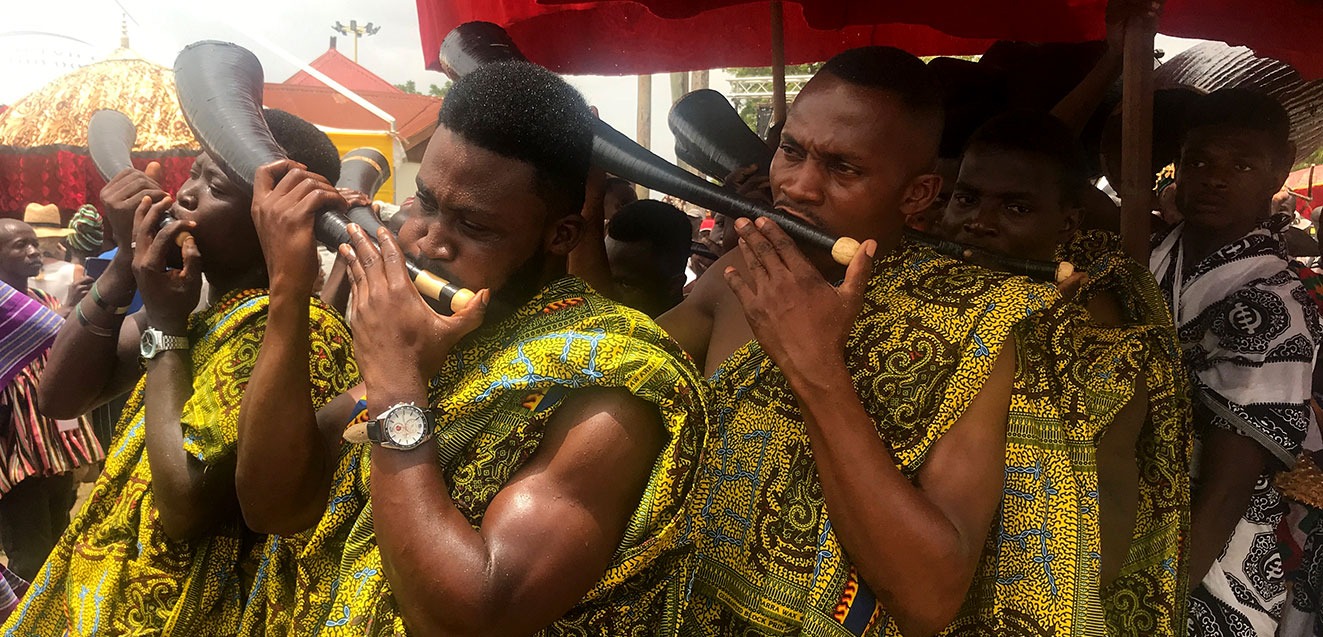
On my first full day in Benin, our guide, Noah, asked our group why we were visiting West Africa. He questioned, “Are you here for the animals or for the people?” Before he let us answer, he was quick to clarify, “If you are here for the animals, we can book you a flight somewhere else. You won’t find them here. Here, we have incredible culture and incredible people.”
Indeed, I had come for the people. Almost immediately there were opportunities to engage with the locals. While driving to the Ganvie Stilt Village, I took in the rhythmic chaos of Cotonou traffic from my window seat on the coach bus. The congested roads were crammed with cars and motorbikes — mostly motorbikes, which were transporting anything and everything. Some carried families of all sizes, many with young children secured onto their mama’s backs with fabric slings. Others carried items to be sold at market, including large sacks of produce, picture frames and other home goods, wheels for bikes and other parts, and a precarious assortment of stacked baskets. Taxi drivers on bikes transported students carrying books and even a man holding an adult-sized goat. Without even thinking about my intention, I made eye contact with an older rider on the back of a motorbike. I smiled. I waved. He looked back at me for a moment, then smiled and waved in return.
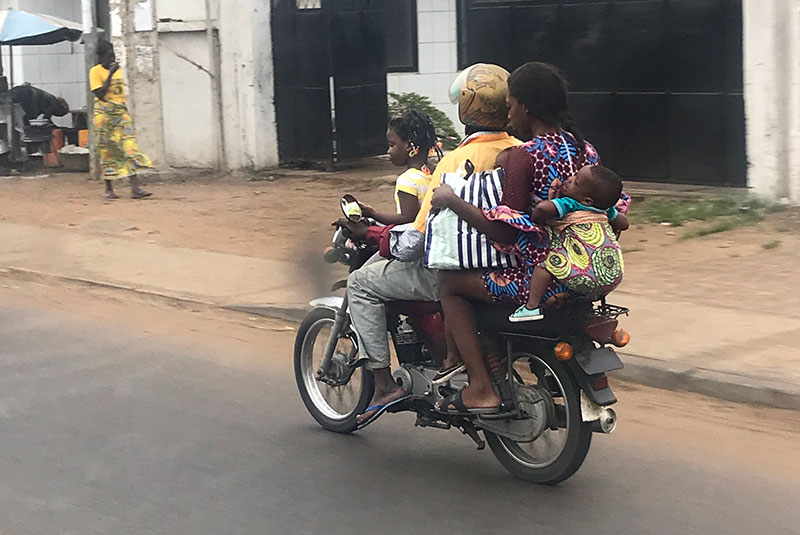
Encounter with the children in Ketou
With the people of Benin, some connections were quick and wordless, like my interaction with the man on the motorbike. Some included dancing and laughter. Others were quite intimate, such as my encounter with the children at a village in Ketou. Though I had been told it was absolutely OK to take photos, when I initially pointed my cell phone camera at these children, their smiles disappeared and were replaced with their most serious faces. Maybe they didn’t realize that my phone was also a camera, I reasoned.
I selected a photo and enlarged it onto the screen of my phone, clearly displaying the group of children. Then I squatted down to their eye level and beckoned them to come towards me. A few were hesitant, but not all. The first boy to reach me looked at the image on the screen. Immediately he dissolved into giggles as he viewed his stoic-looking friends.
His giggles signaled the others to come closer. They did, clambering to see the images of themselves and eager for more photos. As I walked through the village, the children walked closely with me, hoping I’d ask to take their photos. I was happy to oblige.
They delighted in seeing their photos on my iPhone screen, and I think we were equally disappointed when it was time to say goodbye.
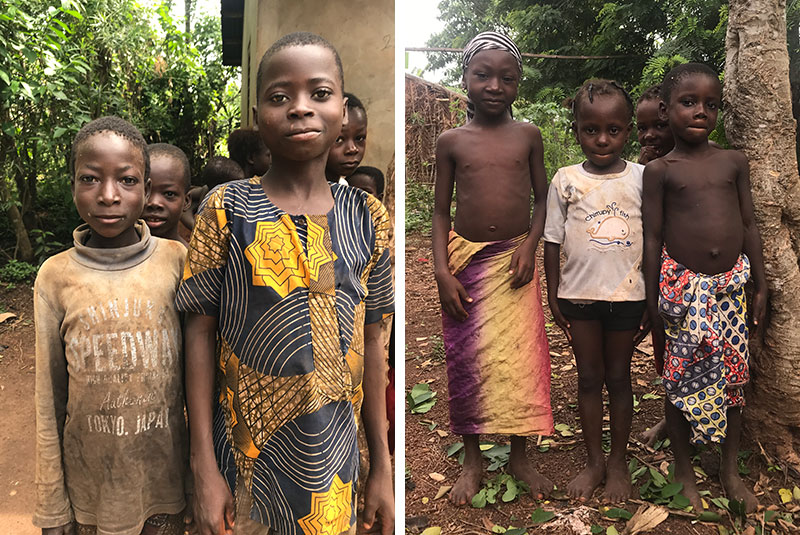
The Masked Dances
During our tour, our group visited several mask dances. The Egungun was by far my favorite, with elaborate costumes and a fantastical game of chase that was both intimidating and playful. The Egungun is a very powerful secret society. Egun masks are the reincarnation of deceased people and are generally feared for their aggressiveness and their unpredictable way of moving around. Intensely colored, the masks are covered with a multitude of pieces of cloth in many shades of red. The masked figures emerge from the forest and form a procession through the streets of the village, leaping towards any spectator who is foolish or daring enough to get too close. Nobody wants to be touched by the Egun because any contact carries the danger of death. But when the figures arrived, the reaction was a mixture of fear and laughter: They performed a kind of bullfight that was meant to scare the crowd, but some spectators greeted their efforts with bursts of laughter.
At the Gelede mask dance, a theatrical performance meant to educate and entertain, Noah shared with us that the mask we were seeing represented the god of fertility. He asked me, “Do you want to have lots of babies?”
I laughed and said, “No. I think I’m good with the one I have.”
The masked figure approached him, and they had a playful interaction. Noah then tossed the horsehair wand to me, indicating it was my turn. The large crowd of villagers howled with laughter as I awkwardly tried to avoid dancing with the mask. I relented and the crowd roared their approval. I tried to mimic the movements of the mask and laughed and laughed.
After several minutes, the mask embraced me, as if thanking me for playing along.
My Friend John in Togo
The Grand Marché in Lomé, Togo, was full of activity, mostly vendors promoting their items calling out to get the attention of those walking by. “Madame!! MADAME! Come see my magnets. For your fridge.”
The vendors spoke French to one another but called to our group in English.
I ignored the man selling magnets, as I had no interest in a magnet shaped like Togo. He chased after me with a metal rod. He demonstrated his magnets.
“See! They stick! You must want!”
I did not.
He was undeterred. “Look! I have others. See this with the colors. Or this with Togo on it.”
I continued walking and he finally relented. The same scenario repeated itself with vendors selling watches, earrings, colorful fans, underwear, and assorted household items.
I didn’t leave the market empty-handed, however. I purchased some gorgeous, colorful waxed cotton fabric from the well-known Nana Benz, women who made their mark internationally by trading in wax-printed cloth.
And after I had said, “Non, merci,” repeatedly, one of the persistent vendors convinced me to buy one of his handmade leather and fabric fans. He had joined our group at the start of the market and had introduced himself as our friend John.
He said to me, “I made this myself. I’ll sell it to you for the same price I sold to the others. I’m your friend John.”
John had successfully sold fans to many others in our group, and after the sale, our group of Americans stood in the 100-degree heat fanning themselves with the colorful souvenirs.
I agreed to his sales pitch and he proudly handed me a fan. I had been offered a better deal from a vendor at the booth next to me, but our friend John got my money.
Later, he optimistically showed me his stall as we passed by, hoping for more sales. I declined but did ask to take his photo with his merchandise. He agreed and smiled proudly. After all, he was my friend.
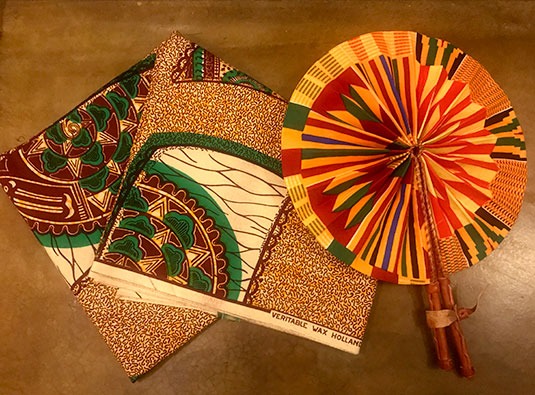
The Spiritual Capital of African Voodoo
Ouidah, in Benin, is considered the spiritual capital of African voodoo. On our journey, visits to a Python Temple, a voodoo priest, and a fetish market exposed us to the traditions and beliefs of voodoo. I have photos of skulls and snake carcasses, and videos of the slaughter of a chicken as a sacrifice for the gods, and of the seizure-like trances of villagers possessed by the spirits.
It was in a village north of Ouidah that we met with the voodoo priest. When we arrived, we passed a handsomely dressed couple driving a luxury car. They had driven from Cotonou to consult with the priest. Benin was having an election at the end of the month, and in voodoo, all important decisions include the wisdom of the priest. Was this possibly a politician looking for guidance with his campaign? It was very likely, according to our guide.
We were escorted to the priest’s abode and waited in the dark and hot space. The priest was delayed because he needed to perform ceremonies related to his prior consultation with the Cotonou couple.
After we had waited about five minutes, the man arrived. He spoke the local dialect. The former mayor had accompanied us and translated into French to our guide, who then translated into English for us.
We could ask questions.
“How do you find the answers to people’s queries?”
“Do you feel a lot of pressure being the spiritual leader for so many people?”
Our questions were translated, and we would wait to hear his response. On several occasions, he was interrupted by the ringing of his cell phone.
“Do you like that we are here visiting you?”
He answered with a huge grin. “Yes, very much. I like it so much that you are here.”
We were then asked if we would like a consultation. A woman in our group said yes. She was instructed to speak her question onto a bill of local currency.
Once her question had been posed, the voodoo priest dumped out his bag of tools. Passed down from generation to generation, the bag contained what appeared to me to be a random assortment of items: shells, bones, sticks and stones, string, washers and bolts, chalk, and so much more. He chanted and sorted through his items.
After about ten minutes, he had his answer. Our guide shared reluctantly, “Whatever your question, he said it is not to be.”
Awkward silence followed.
As we exited, goats bleated. I walked alongside the woman in silence, trying to make sense of what we had just experienced.
“You were very brave for being willing to ask a question,” I told her. The goats bleated their agreement.
The Fetish Market
The fetish market, the Marché des Féticheurs, was in Togo. That market was filled with stalls hawking animal parts and curious powders to be used in animist traditional medicine. There were mummified baboons, dried goat heads, horsetail wands, porcupine quills, dried frogs, snake skins, cheetah skins, and a variety of other no-longer-living animals.
A young vendor tried to sell me a white necklace made from the skeleton of a snake. I thought it was kind of chic looking, but to his chagrin, I declined.
We then met with a voodoo priest to learn about fetishes. His helper passed us each four items. The first was a reddish wood cylinder with a small hole tied to a smaller piece of wood. It was a fetish for good travel—you would speak your wish into the hole and then seal it in with the small wooden dowel. It worked for 24 hours, then you had to repeat the process.
There were also fetishes for finding love, prosperity in business, and good sleep.
The market was running a tourist special: Any fetish that we would buy would include a blessing by the priest.
I bought my partner the good sleep fetish made from a smooth, round seed and had it blessed, then returned the other three fetishes on my way out.
Later, another traveler mentioned that she had kept all of the fetishes, thinking they were a gift to us and part of the voodoo program.
She had inadvertently stolen from the voodoo market and priest! Our group wondered aloud if she would be hexed.
A Possible Hex?
The next day, our coach was sideswiped by a new driver. While it was a minor incident, it seemed like a bad omen for someone that had absconded with a safe travel amulet.
We quizzed the woman, “How did you sleep last night?”
“I slept terribly last night,” she said. “My alarm went off at 1:30 am. I didn’t realize the time, so I got up and began packing my suitcase. Once I realized the time, I went back to bed. My alarm went off at 3:30 am and I got up and took a shower and got dressed. I didn’t realize it was the wrong time again! I got a very bad sleep.”
The woman had also been on the cusp about a new relationship, texting and conversing each day with her suitor. She had ended things with him that night.
Concerned, we considered returning the fetishes to the voodoo priest–despite being in a different country by that point.
Our guide told the fah (universe) that the stolen fetishes had been taken unintentionally and that the woman did not know she was stealing.
All was well after that.
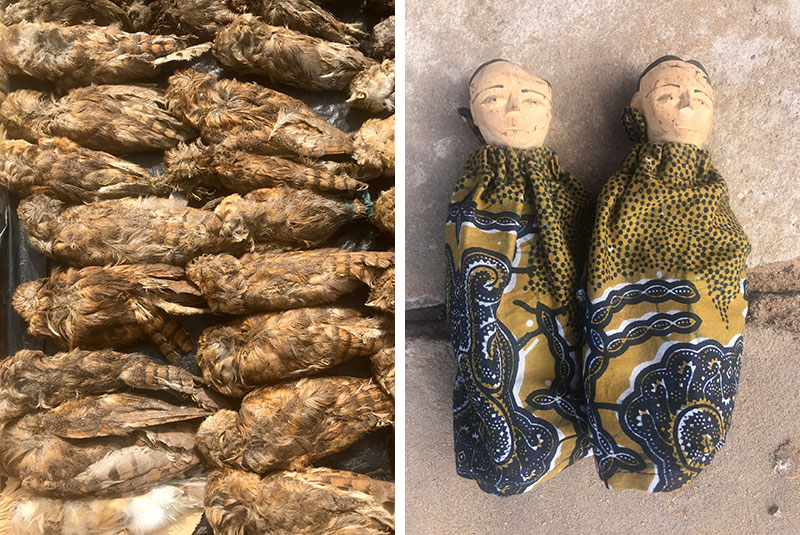
Asantehene, the Ashanti King
Easter Sunday coincided with the Festival of Akwasidae, a monthly celebration with dancing and music that is held at the Ashanti king’s palace. At this celebration, Ashanti chiefs offer adoration to the Golden Stool and visitors gather and pay homage to the Asantehene, the Ashanti king (a strictly ceremonial position).
Serendipitously, this Akwasidae was very special, celebrating the king’s 20th anniversary on the Golden Stool. As a result, the event was much larger in size than normal. The President of Ghana was in attendance, as were many other political representatives and VIPs from around the world.
It was indescribably thrilling to be surrounded by the sights and sounds of the event. Attendees wore their finest clothes and were in high spirits. People streamed into the venue, which was approximately the size of a football field. The procession of Ashanti chiefs took many, many hours, with each group chanting and drumming and celebrating, bringing along weapons, drums, gold staffs, thrones, animal skins, and goats (offerings for the king).
Loud explosions, which for an American could be terrifying to hear at such a crowded event, were commonplace. A series of gunshot blasts next to me made me flinch, much to the amusement of the locals next to me. We laughed together as I acknowledged my tourist status.
By the time the king had made his entrance, there were over 10,000 people crammed together. It was extremely hot and extremely crowded, and yet the crowd was thrilled to be in attendance. There was no open space at all, just a sea of sweaty, finely dressed revelers.
I asked someone about the intense crowd size, and he said, “The king feels very proud when he sees such a large crowd. He loves to see everyone here celebrating him. It makes him happy. And we like to make our king happy.”
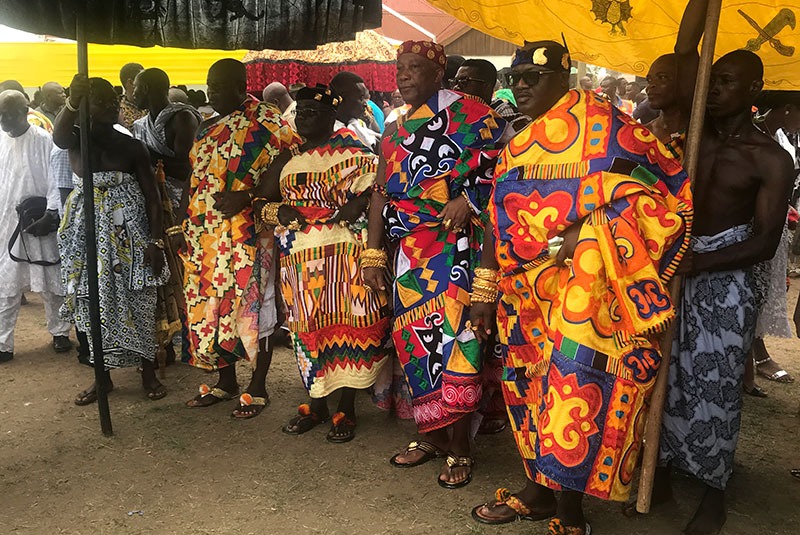
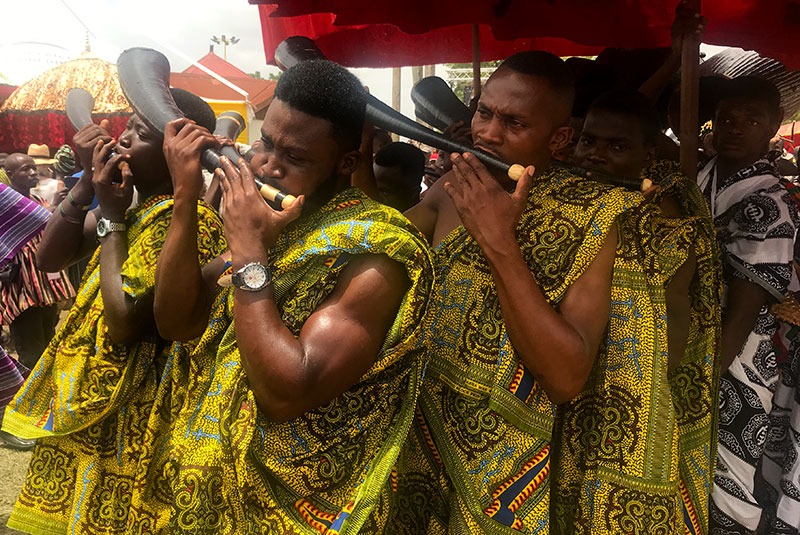
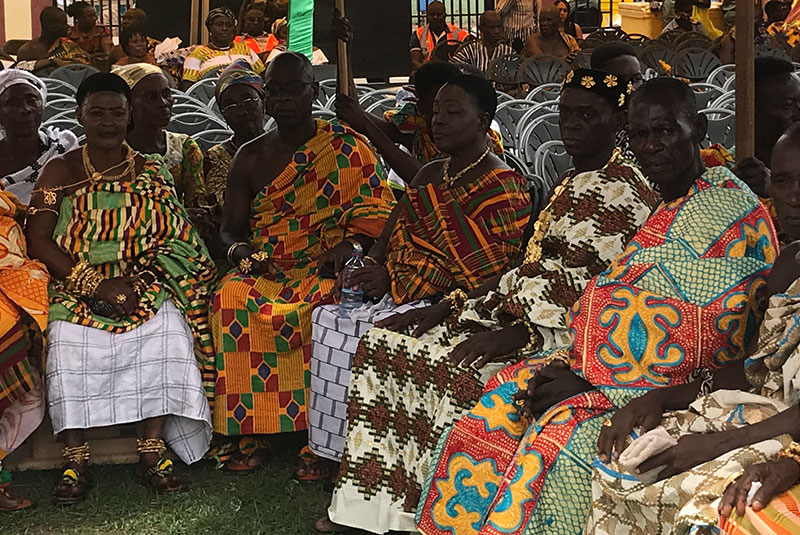
Parade of Chiefs
The parade of chiefs entering the festival reminded me of the parade of countries at the Olympic’s opening ceremonies. Each village was different, some with large groups and elaborate umbrellas, varying golden objects, weapons, and offerings for the king, representing their people and communities. There were small congregations with simple umbrellas and clothes, and large groups dancing and singing and cheering. Some chiefs were very stoic, staring out at the crowd. Others, including the Ashanti king, were exuberant, enjoying the opportunity to engage with the crowd. They would dance about to the delight of their followers and the spectators.
A Land of Colors
Africa is a land of colors: deep green foliage, rust-red soil, golden sand, ever-changing blue-hued water, brightly colored fabrics, textiles, and baskets, elaborately decorated masks, and adornments.
Even the fishing boats are brightly decorated. At Kayar, Senegal’s largest fishing village, there were thousands of people on the shore waiting for the arrival of the fishing boats and the tons and tons of fish caught. Everyone had a role. The men ran out to the boats and collected the fish. The women sorted and cleaned the fish. The men negotiated pricing, exporting fish to countries like Japan and African countries that don’t have coastal access. There was even a boat painting department! Boats are repainted each year by the boat painters. Each design is different and identifies the family that owns the boat.
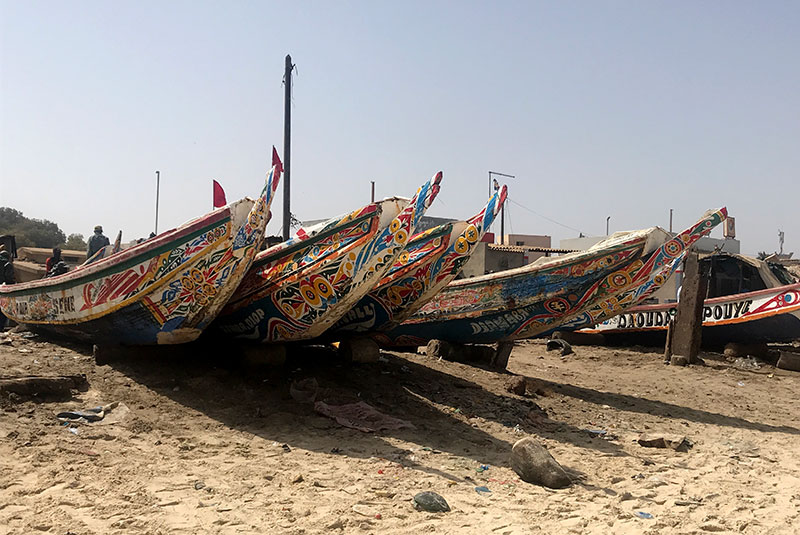
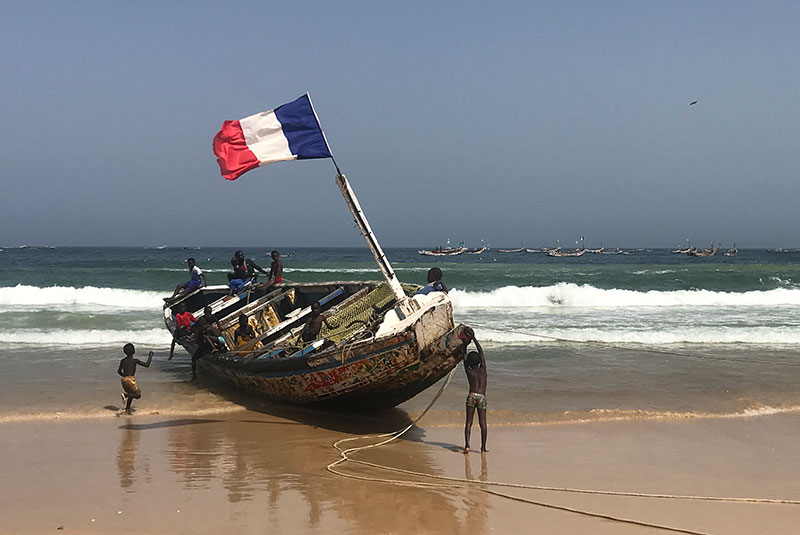

The City of the Arts
Dakar, the capital of Senegal, is a city of the arts. While touring the various galleries, museums, and street art was all incredible, my favorite was the Village des Arts. Here some of the country’s most promising and established painters, sculptors, and mixed media artists create and display their works in individual studios scattered around a large garden space.
If a studio door is open, you ask the artist for permission to enter. While my French didn’t allow me too many meaningful conversations, I did say, “très bien” and “très jolie” frequently enough to wish I had a larger vocabulary.
I met Baye Mballo, a retired art director for several of Dakar’s finest museums. He was mentoring young artists at the village and shared with me his scrapbook. It was filled with images and articles about his long and successful career.
He shared that his specialty was children and music. He had photos of gorgeous watercolors of jazz musicians and joyful children. If he had had them available for sale, I would have eagerly purchased one.
“Très jolie. Merci. Merci beaucoup,” was all I could share in return.
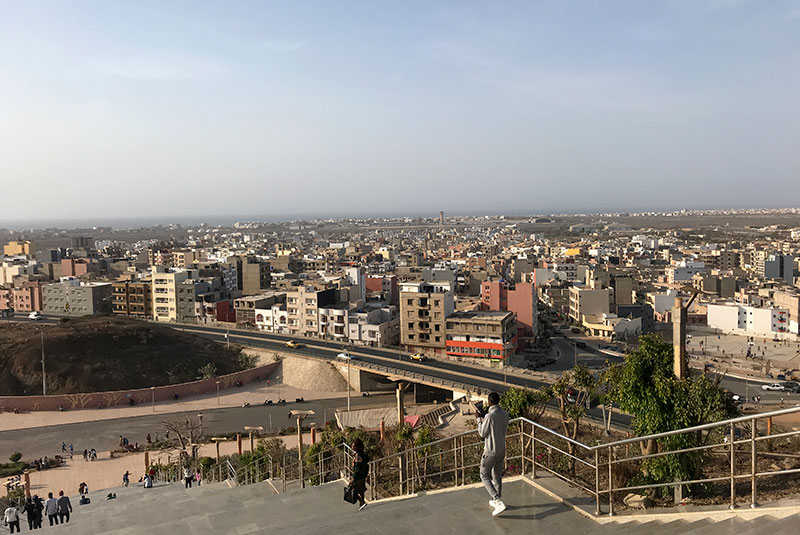
Late-night Culture
Dakar has a vibrant music culture centered on native mbalax music, a blend of traditional Senegalese dance and drum music (sabar) and Western jazz, soul, Latin, and rock. Each night, throughout the city, a variety of venues offer live music in small venues. Music is scheduled to begin at 9 pm, but in African time, that typically means the musicians show up after 9:30 pm and begin playing after 10 pm. The late-night is worth it.
To learn more about our Mystical West Africa trip, call our experts at 888-570-7108.

